The Featured Creatures collection provides in-depth profiles of insects, nematodes, arachnids and other organisms relevant to Florida. These profiles are intended for the use of interested laypersons with some knowledge of biology as well as academic audiences.
Introduction
Four species of "cotton stainers," also known as "red bugs," are known from Florida. However, the most important of these is the cotton stainer, Dysdercus suturellus (Herrich- Schaeffer). Morrill (1910) stated the cotton stainer was the most destructive cotton pest in Florida. Currently, the cotton stainer is a minor pest of cotton, and then only in the southern part of the state.
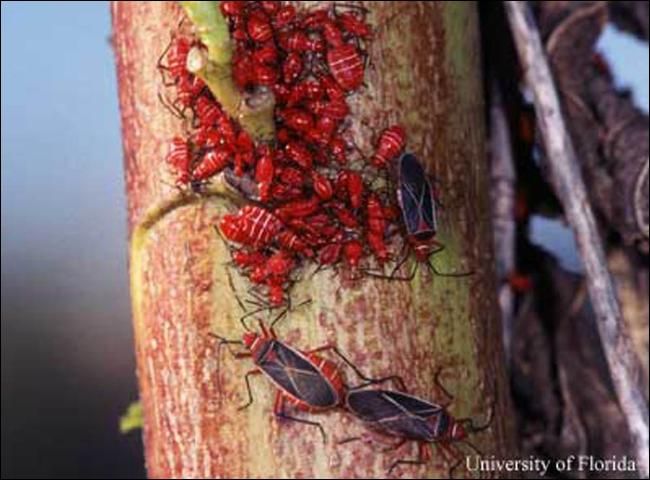
Credit: Lyle J. Buss, UF/IFAS
This species lost its importance on cotton during the mid-twentieth century, primarily because of the elimination of cotton waste that provided breeding and overwintering sites, but also due to effective chemical controls. However, during that period cotton also lost its former eminence as a crop in Florida. Maximum acreage of cotton in Florida occurred in 1911 and amounted to 319,000 acres. By 1920, it was down to 100,000 acres and remained at about that level until 1937, when a downward trend began. In 1965, 22,000 acres were planted, and in 1966 only an estimated 15,000 acres were planted. However, in the mid-1990s cotton planting experienced a resurgence. In 2003, 109,000 acres were planted in northern Florida. In 2004, acreage was expected to increase by another 5,000 acres (Sprenkel 2004).
Cotton stainers are currently noteworthy because of their presence on and occasional damage to fruits and ornamentals, particularly malvaceous plants such as Hibiscus spp.
Distribution
The cotton stainer is most common in southern Florida and in Cuba. It has been reported in Jamaica and Puerto Rico, Alabama, Georgia, and South Carolina. In view of its scarcity in north Florida, it must be presumed rare in the other three states mentioned. Dysdercus andreae ranges from southern Florida to most of the Antilles and Surinam. Dysdercus mimulus ranges from southern Florida, Texas, and Mexico into Central America and the West Indies. The fourth, undetermined species is known in the United States from two specimens taken at Key Largo Key and Homestead, Florida.
Description and Habits
Eggs
Dysdercus eggs look very much like microscopic hens' eggs. They are pale yellow are laid singly or in small, loose clusters in sand, debris, or decaying vegetable matter. They hatch in about one week.
Nymphs
There are five nymphal stages or instars. The first usually is spent underground. The duration of each of the first four stages typically averages four to five days during midsummer, but the fifth stage commonly takes about twice as long. All five stages require from 21 to 35 days to complete development. The nymphs are generally red. The fourth and fifth instars have dark wing pads, and the dividing lines between abdominal segments becomes very distinct as maturity is approached.
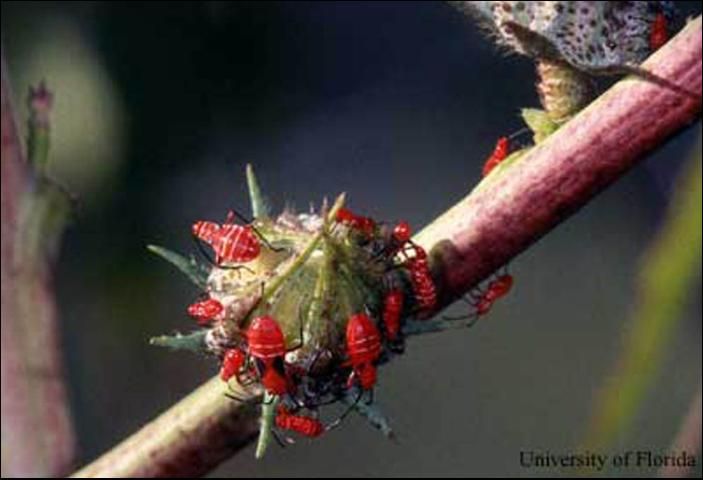
Credit: Lyle J. Buss, UF/IFAS
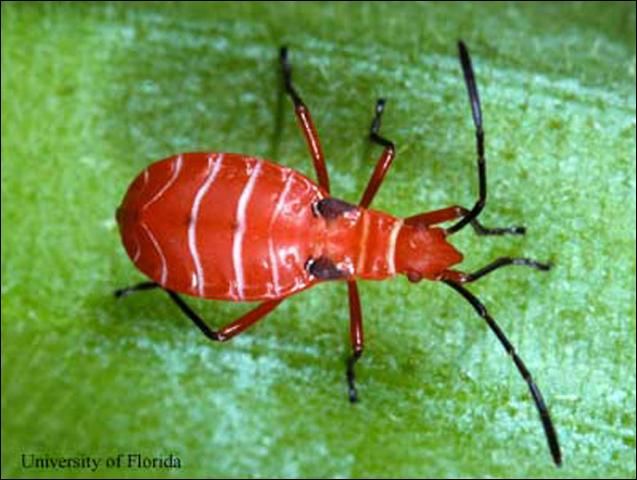
Credit: Lyle J. Buss, UF/IFAS
Adults
This adult is narrow, around 3/5 inch long, long legged, has a bright red thorax, and brown wings crossed with yellow.
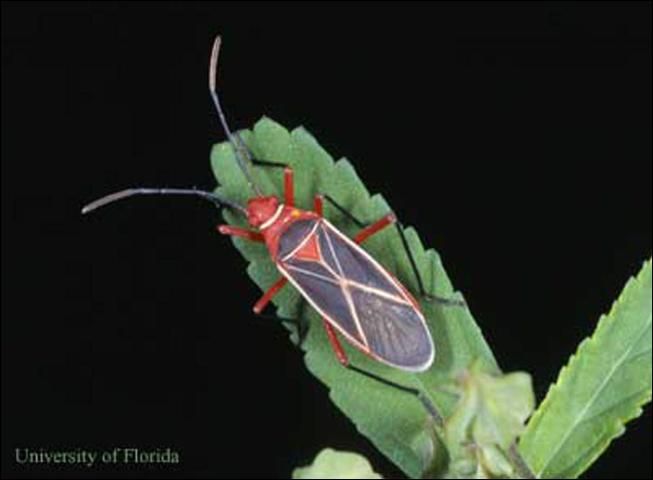
Credit: Lyle J. Buss, UF/IFAS
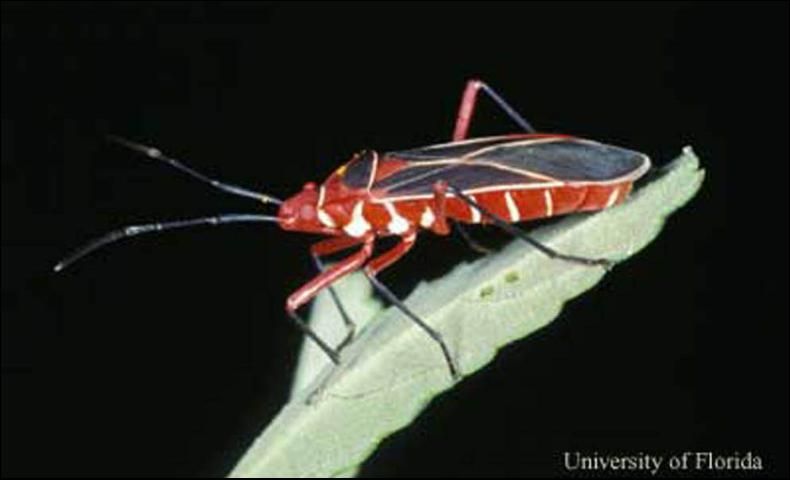
Credit: Lyle J. Buss, UF/IFAS
There are several generations a year. The life cycle can vary from about a month to three and a half months, depending primarily upon temperature differences. The various species are attracted to lights.
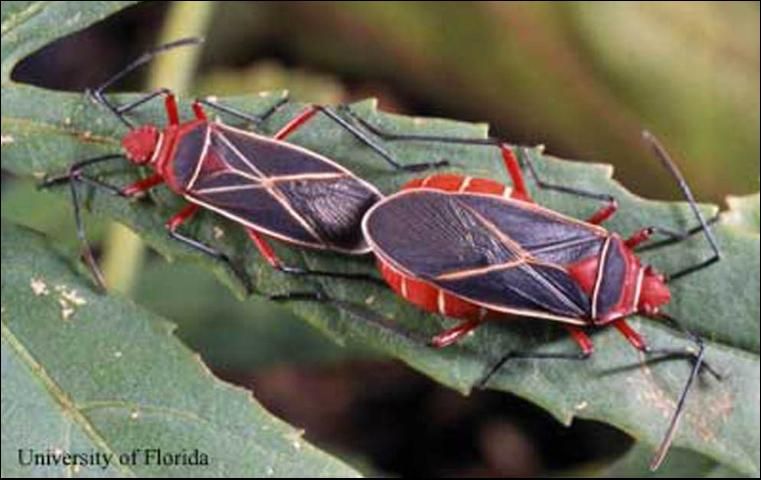
Credit: Lyle J. Buss, UF/IFAS
Key to Adults
1. Corium primarily red or reddish orange surrounding a black spot or bar . . . . 2
1'. Corium light to dark brown, not reddish; black spot absent, but a dark bar sometimes variously developed from obscure to distinct . . . . . 3
2(1). Length over 13 mm; corium and clavus without pale borders; black spot of corium round and large; scutellum at least partly darkened; collar of pronotum concolorous red; clavus embrowned adjacent to scutellum only . . . . . very rare undetermined species
2'. Length under 12.5 mm; corium and clavus with pale margins forming a "St. Andrews Cross"; black spots of corium variable in shape and size but not round and generally forming a transverse bar near base of membrane; scutellum entirely reddish; collar of pronotum contrasting pale yellow; clavus entirely brown . . . . . andreae
3(1'). Length 12–17 mm; antennal segment I distinctly longer than segment II, the latter approximately 7/10ths the length of the basal segment . . . . . suturellus
3'. Length 10 mm or less; antennal segment I equal or subequal to segment II . . . . . mimulus
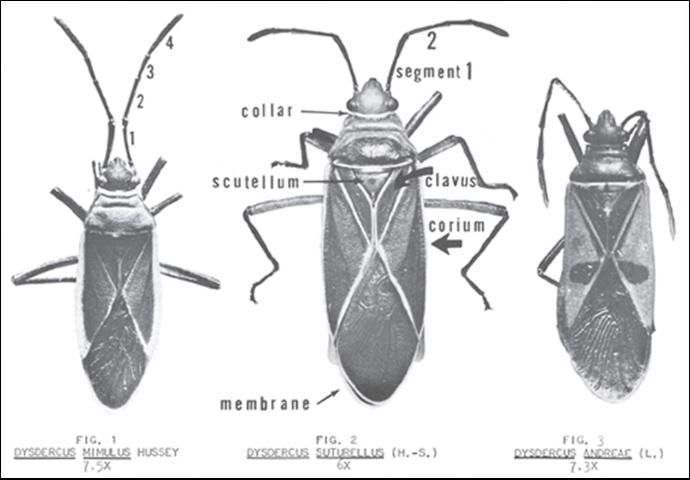
Credit: Division of Plant Industry
Hosts and Economic Importance
Medium to large-sized nymphs and adults feed on seeds in developing cotton bolls. The cotton stainer derives its name from its habit of staining cotton an indelible brownish yellow. A grower at Hawthorne, Florida, in 1902 ginned about 1,000 bales of long-staple cotton, of which about 200 bales were classed as stained. Dysdercus suturellus punctures and sucks young bolls, preventing them from coming to maturity.
This insect has been a severe pest of oranges on occasion. In puncturing an orange, a cotton stainer often inserts its beak full length with no visible wound; nevertheless, a single puncture may cause the orange to drop in a few hours from the tree and to decay in one or two days (Hubbard 1885). There are old reports of orange trees well reddened with cotton stainers in which whole crops were lost.
Some other hosts of Dysdercus suturellus include tangerines, okra pods, ripe papaya fruit, pods and blossoms of oleander, seed pods of Jamaica sorrel (Hibiscus sabdariffa), tree hibiscus (Hibiscus syriacus), Turk's cap, teaweed (Sida sp.), Caesar's weed or Spanish cocklebur (Urena lobata), Spanish needle (Bidens pilosa), seaside mahoe or portiatree (Thespesia populnea), rose buds and blossoms, eggplant, nightshade, and guava. The hosts of the other species of Dysdercus are essentially the same as for Dysdercus suturellus. The Division of Plant Industry has one record of royal poinciana being severely damaged by Dysdercus andreae.
The feeding activities of cotton stainers on cotton produce a stain on the lint which reduces its value. A few authorities have reported the stain comes from excrement of the bugs. However, most have stated that the stain primarily is a result of the bug puncturing the seeds in the developing bolls causing a juice to exude that leaves an indelible stain. Feeding by puncturing flower buds or young cotton bolls usually causes a reduction in size, or the fruiting body may abort and drop to the ground.
Management
No cotton or cotton seed or other host plant debris that could serve as breeding material should be left on the ground. For small infestations, colonies of cotton stainers on plants can be shaken into a bucket of soapy water. "Tanglefoot" around tree trunks will keep young bugs from crawling up to fruits and blossoms. Small heaps of seeds, fruits, or bits of sugarcane can be used as baits to attract cotton stainers. Then the insects can be killed with a spray of soapy water. Insecticides can be used on ornamentals and fruits, but tolerances must be observed on edible fruits. Follow label recommendations. Management information for Dysdercus on ornamentals in Florida is very limited.
Selected References
Ballou HA. 1906. Cotton stainers. West Indian Bulletin 7: 64–85.
Callan E McC. 1947. Cotton stainers (Dysdercus spp.) in the West Indies. Bulletin of Entomological Research 37: 389–391.
Hubbard HG. 1885. Orange Insects. U.S. Department of Agriculture Division of Entomology. pp. 165–168.
Morrill AW. 1910. Plant-bugs injurious to cotton bolls. USDA, Bureau of Entomology Bulletin 86: 95–100.
Riley CV, Howard LO. 1889. The red bug or cotton stainer. Insect Life 1: 234–241.
Sprenkel RK. Re: Cotton stainer acreage. (18 March 2004).
Squire FA. 1939. Observations on cotton stainers (Dysdercus) in the West Indies. Bulletin of Entomological Research 30: 289–292.
Withycombe CL. 1924. Factors influencing the control of cotton-stainers (Dysdercus spp.). Bulletin of Entomological Research 15: 171.